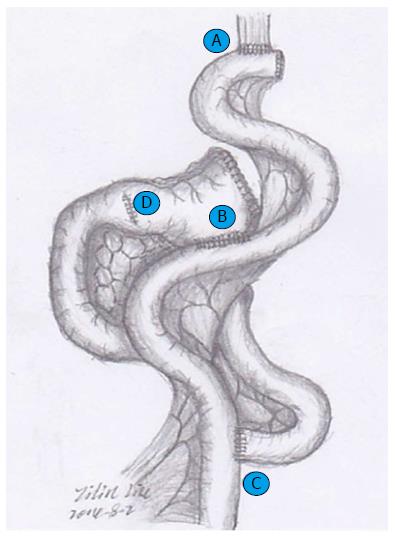Copyright
©The Author(s) 2015.
World J Gastroenterol. Sep 14, 2015; 21(34): 9999-10007
Published online Sep 14, 2015. doi: 10.3748/wjg.v21.i34.9999
Published online Sep 14, 2015. doi: 10.3748/wjg.v21.i34.9999
Figure 2 Antrum-preserving double-tract reconstruction.
In our study, the jejunum was divided approximately 20 cm distal to the ligament of Treitz, an end-to-side esophagojejunal anastomosis (A) was performed, and the bottom of the proximal jejunum limb was anastomosed to the side of the Roux limb using a circular stapler at approximately 35 cm distal to the esophagojejunal anastomosis (C). Then, a side-to-side gastrojejunal anastomosis (B) was performed at 20 cm to the jejunojejunal anastomosis, and a pyloroplasty (D) was necessarily implemented.
-
Citation: Xiao JW, Liu ZL, Ye PC, Luo YJ, Fu ZM, Zou Q, Wei SJ. Clinical comparison of antrum-preserving double tract reconstruction
vs roux-en-Y reconstruction after gastrectomy for Siewert types II and III adenocarcinoma of the esophagogastric junction. World J Gastroenterol 2015; 21(34): 9999-10007 - URL: https://www.wjgnet.com/1007-9327/full/v21/i34/9999.htm
- DOI: https://dx.doi.org/10.3748/wjg.v21.i34.9999









